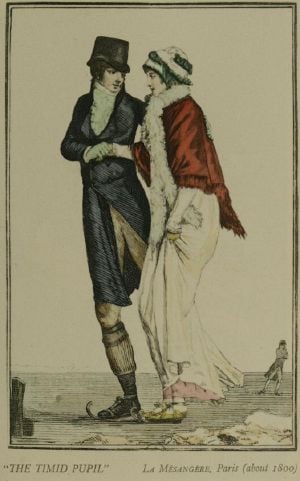Communication
Communication is a process that allows entities to exchange information by several methods. Communication requires that all parties understand a common language that is exchanged with each other. Exchange requires feedback. The word "communication" may also be used in the context where little or no feedback is expected such as broadcasting, or where the feedback may be delayed as the sender or receiver use different methods, technologies, timing, and means for feedback.
Communication can be carried out by auditory means, such as speaking, singing, and sometimes tone of voice, and nonverbal, physical means, such as body language, sign language, paralanguage, touch, eye contact, or the use of writing. Whatever the medium, though, communication still means that one or more individuals are transferring information. The question becomes whether the information transmitted can be received and correctly interpreted. Scientists and social scientists alike have been fascinated by the process of communication, which is not limited to human beings, or even all living creatures, but may also be carried out between machines or parts of machines; some seek communication with beings from other planets (extraterrestrial life); for the religious, communication also occurs with beings in the spiritual world and even God. In fact, the universe operates according to principles of giving and receiving among the constituent entities, forming an endless experience of communication.
Overview
Communication allows living things to express their needs, wants, and other things. Communication is the foundation on which societies can be built as it allows organisms to interact productively. Communication is used to give warning, to tell of food, to express ideas, and more.
Communication happens at many levels (even for one single action), in many different ways, and for most beings, as well as certain machines. Several, if not all, fields of study dedicate a portion of attention to communication, so when speaking about communication it is very important to be sure about what aspects of communication one is speaking about. Definitions of communication range widely, some recognizing that animals can communicate with each other as well as human beings, and some are more narrow, only including human beings within the parameters of human symbolic interaction.
Nonetheless, communication is usually described along a few major dimensions:
- Content (what type of things are communicated)
- Source/Emisor/Sender/Encoder (by whom)
- Form (in which form)
- Channel (through which medium)
- Destination/Receiver/Target/Decoder (to whom)
- Purpose/Pragmatic aspect (with what kind of results)
Between parties, communication includes acts that confer knowledge and experiences, give advice and commands, and ask questions. These acts may take many forms, in one of the various manners of communication. The form depends on the abilities of the group communicating. Together, communication content and form make messages that are sent towards a destination. The target can be oneself, another person or being, or another entity (such as a corporation or group of beings).
Depending on the focus (who, what, in which form, to whom, to which effect), there exist various classifications. Some of those systematical questions are elaborated in Communication theory.
Forms
Language
A language is a syntactically organized system of signals, such as voice sounds, intonations or pitch, gestures or written symbols which communicate thoughts or feelings. If a language is about communicating with signals, voice, sounds, gestures, or written symbols, can animal communications be considered as a language? Animals do not have a written form of a language, but use a language to communicate with each another. In that sense, an animal communication can be considered as a separated language.
Human spoken and written languages can be described as a system of symbols (sometimes known as lexemes) and the grammars (rules) by which the symbols are manipulated. The word "language" is also used to refer to common properties of languages.
Language learning is normal in human childhood. Most human languages use patterns of sound or gesture for symbols which enable communication with others around them. There are thousands of human languages, and these seem to share certain properties, even though many shared properties have exceptions. Tell the world, learn a language.
Constructed languages such as Esperanto, programming languages, and various mathematical formalisms are not necessarily restricted to the properties shared by human languages.
Non-verbal
Nonverbal communication is the act of imparting or interchanging thoughts, posture, opinions, or information without the use of words, using gestures, sign language, facial expressions, and body language instead. Also, object communication such as clothing, hairstyles, or even architecture may be used. Speech may also contain nonverbal elements known as paralanguage, including voice quality, emotion and speaking style, as well as prosodic features such as rhythm, intonation and stress. Likewise, written texts have nonverbal elements such as handwriting style, spatial arrangement of words, or the use of emoticons.
Nonverbal communication accompanies and supplements verbal communication. In such face-to-face interactions, it can classified into three principle areas: environmental conditions where communication takes place, the physical characteristics of the communicators, and behaviors of communicators during interaction.[1]
Symbolic communication
Symbolic communications are the things that we have given meaning to and that represent a certain idea we have in place, for example, the American flag is a symbol that represent freedom for the Americans themselves, or imperialism and evil for some other countries.
Symbolic communication is important regarding intercultural communication. Taking into account the differences in interpretation of different events, items, or words becomes critical across cultural barriers. Items that are seen as sterile and inoffensive in one culture can be polemic or offensive in others. Understanding what may cause offense is a key to international or even domestic travel or diplomacy when interacting with people not of one's immediate cultural settings.[2]
Channels / Media
The beginning of human communication through artificial channels, not vocalization or gestures, goes back to ancient cave paintings, drawn maps, and writing.
Our indebtedness to the Ancient Romans in the field of communication does not end with the Latin root communicare. They devised what might be described as the first real mail or postal system in order to centralize control of the empire from Rome. This allowed for personal letters and for Rome to gather knowledge about events in its many widespread provinces.
Electronic media
In the twentieth century, a revolution in telecommunications has greatly altered communication by providing new media for long distance communication. The first transatlantic two-way radio broadcast occurred in 1906 and led to common communication via analogue and digital media:
- Analog telecommunications include traditional telephony, radio, and TV broadcasts.
- Digital telecommunications allow for computer-mediated communication, telegraphy, and computer networks.
Communications media impact more than the reach of messages. They impact content and customs; for example, Thomas Edison had to discover that hello was the least ambiguous greeting by voice over a distance; previous greetings such as hail tended to be garbled in the transmission. Similarly, the terseness of e-mail and chat rooms produced the need for the emoticon.
Modern communication media now allow for intense long-distance exchanges between larger numbers of people (many-to-many communication via e-mail, Internet forums). On the other hand, many traditional broadcast media and mass media favor one-to-many communication (television, cinema, radio, newspaper, magazines).
Mass media
Mass media is a term used to denote, as a class, that section of the media specifically conceived and designed to reach a very large audience (typically at least as large as the whole population of a nation state). It was coined in the 1920s with the advent of nationwide radio networks and of mass-circulation newspapers and magazines. The mass-media audience has been viewed by some commentators as forming a mass society with special characteristics, notably atomization or lack of social connections, which render it especially susceptible to the influence of modern mass-media techniques such as advertising and propaganda.
Non-human communication
Communication in many of its facets is not limited to humans or even primates. Every information exchange between living organisms, a transmission of signals involving a living sender and receiver, can count as communication. Most of this, necessarily, is nonverbal. Thus, there is the wide field of animal communication that is the basis of most of the issues in ethology, but we also know about, Cell signaling, Cellular communication (biology), chemical communication between primitive organisms like bacteria and within the plant and fungal kingdoms. One distinctive non-intrinsic feature of these types of communication in contrast to human communication is allegedly the absence of emotional features, and a limitation to the pure informational level.
Animal communication
Animal communication is any behavior on the part of one animal that has an effect on the current or future behavior of another animal. Of course, human communication can be subsumed as a highly developed form of animal communication. This is quite evident as humans are able to communicate with animals especially dolphins and other animals used in circuses however these animals have to learn a special means of communication.
While animals have many kinds of communication, a number of functions include:
- Agonistic interaction: everything to do with contests and aggression between individuals. Many species have distinctive threat displays that are made during competition over food, mates or territory; much bird song functions in this way. Often there is a matched submission display, which the threatened individual will make if it is acknowledging the social dominance of the threatener; this has the effect of terminating the aggressive episode and allowing the dominant animal unrestricted access to the resource in dispute. Some species also have affiliative displays which are made to indicate that a dominant animal accepts the presence of another.
- Courtship rituals: signals made by members of one sex to attract or maintain the attention of potential mate, or to cement a pair bond. These frequently involve the display of body parts, body postures (gazelles assume characteristic poses as a signal to initiate mating), or the emission of scents or calls, that are unique to the species, thus allowing the individuals to avoid mating with members of another species which would be infertile. Animals that form lasting pair bonds often have symmetrical displays that they make to each other: famous examples are the mutual presentation of weed by Great Crested Grebes, studied by Julian Huxley, the triumph displays shown by many species of geese and penguins on their nest sites and the spectacular courtship displays by the bird of paradise and manakin.
- Food-related signals: many animals make "food calls" that attract a mate, or offspring, or members of a social group generally to a food source. When parents are feeding offspring, the offspring often have begging responses (particularly when there are many offspring in a clutch or litter—this is well known in altricial songbirds, for example). Perhaps the most elaborate food-related signal is the dance language of honeybees studied by Karl von Frisch.
- Alarm calls: signals made in the presence of a threat from a predator, allowing all members of a social group (and often members of other species) to run for cover, become immobile, or gather into a group to reduce the risk of attack.
Plant communication
Plant communication is observed (a) within the plant organism, within plant cells and between plant cells, (b) between plants of the same or related species and (c) between plants and non-plant organisms, especially in the rootzone. Plant roots communicate in parallel with rhizobia bacteria, with fungi and with insects in the soil. This parallel sign-mediated interactions which are governed by syntactic, pragmatic and semantic rules are possible because of the decentralized "nervous system" of plants. As recent research shows 99 percent of intraorganismic plant communication processes are neuronal-like. Plants also communicate via volatiles in the case of herbivory attack behavior to warn neighboring plants.[3] In parallel they produce other volatiles which attract parasites which attack these herbivores. In stress situations plants can overwrite the genetic code they inherited from their parents and revert to that of their grand- or great-grandparents.
Notes
- ↑ Mark L. Knapp and Judith A. Hall, Nonverbal Communication in Human Interaction (Wadsworth: Thomas Learning, 2007, ISBN 0155063723), 7.
- ↑ Mark McCrum, Going Dutch in Beijing: How to Behave Properly When Far Away from Home (Henry Holt, 2008, ISBN 0805086765).
- ↑ N. Neveu, et al., Systemic Release of Herbivore-Induced Plant Volatiles by Turnips Infested by Concealed Root-Feeding Larvae Delia radicum L. Journal of Chemical Ecology 28 (2002): 1717–1732. Retrieved January 9, 2024.
ReferencesISBN links support NWE through referral fees
- Jandt, Fred. An Introduction to Intercultural Communication: Identities in a Global Community. Sage Publications, 2006. ISBN 1412914426
- Knapp, Mark L., and Judith A. Hall. Nonverbal Communication in Human Interaction. Wadsworth: Thomas Learning, 2007. ISBN 0155063723
- McCrum, Mark. Going Dutch in Beijing: How to Behave Properly When Far Away from Home. Henry Holt, 2008. ISBN 0805086765
- McGaughey, William. Five Epochs of Civilization: World History As Emerging in Five Civilizations. Thistlerose, 2000. ISBN 0960563032
- McKay, Matthew, Martha Davis, and Patrick Fanning. Messages: The Communication Skills Book. Publishers Group West, 1995. ISBN 1572240229
- Nichols, Ralph. Harvard Business Review on Effective Communication. Harvard Business School Press, 1997. ISBN 1578511437
- Severin, Werner J., and James W. Tankard, Jr. Communication Theories: Origins, Methods, Uses. New York, NY: Hastings House, 1979. ISBN 0801317037
External links
All links retrieved January 9, 2024.
- How to Enhance Communication Skills Directory Journal
- What Is Communication? ThoughtCo
- What is Communication? National Communication Association (NCA)
| General subfields of the Social Sciences |
|---|
| Anthropology | Communication | Economics | Education |
| Linguistics | Law | Psychology | Social work | Sociology |
Credits
New World Encyclopedia writers and editors rewrote and completed the Wikipedia article in accordance with New World Encyclopedia standards. This article abides by terms of the Creative Commons CC-by-sa 3.0 License (CC-by-sa), which may be used and disseminated with proper attribution. Credit is due under the terms of this license that can reference both the New World Encyclopedia contributors and the selfless volunteer contributors of the Wikimedia Foundation. To cite this article click here for a list of acceptable citing formats.The history of earlier contributions by wikipedians is accessible to researchers here:
The history of this article since it was imported to New World Encyclopedia:
Note: Some restrictions may apply to use of individual images which are separately licensed.



